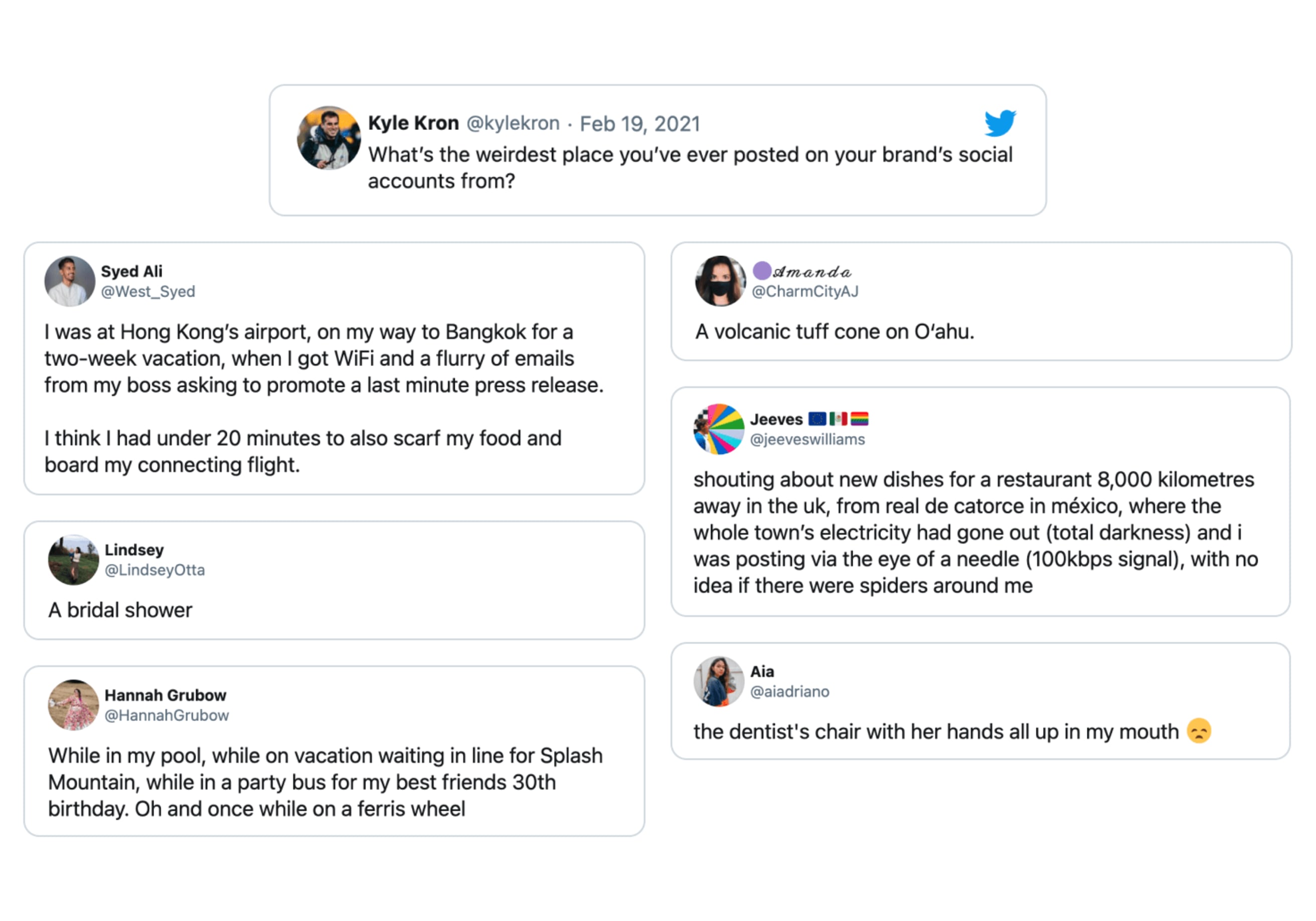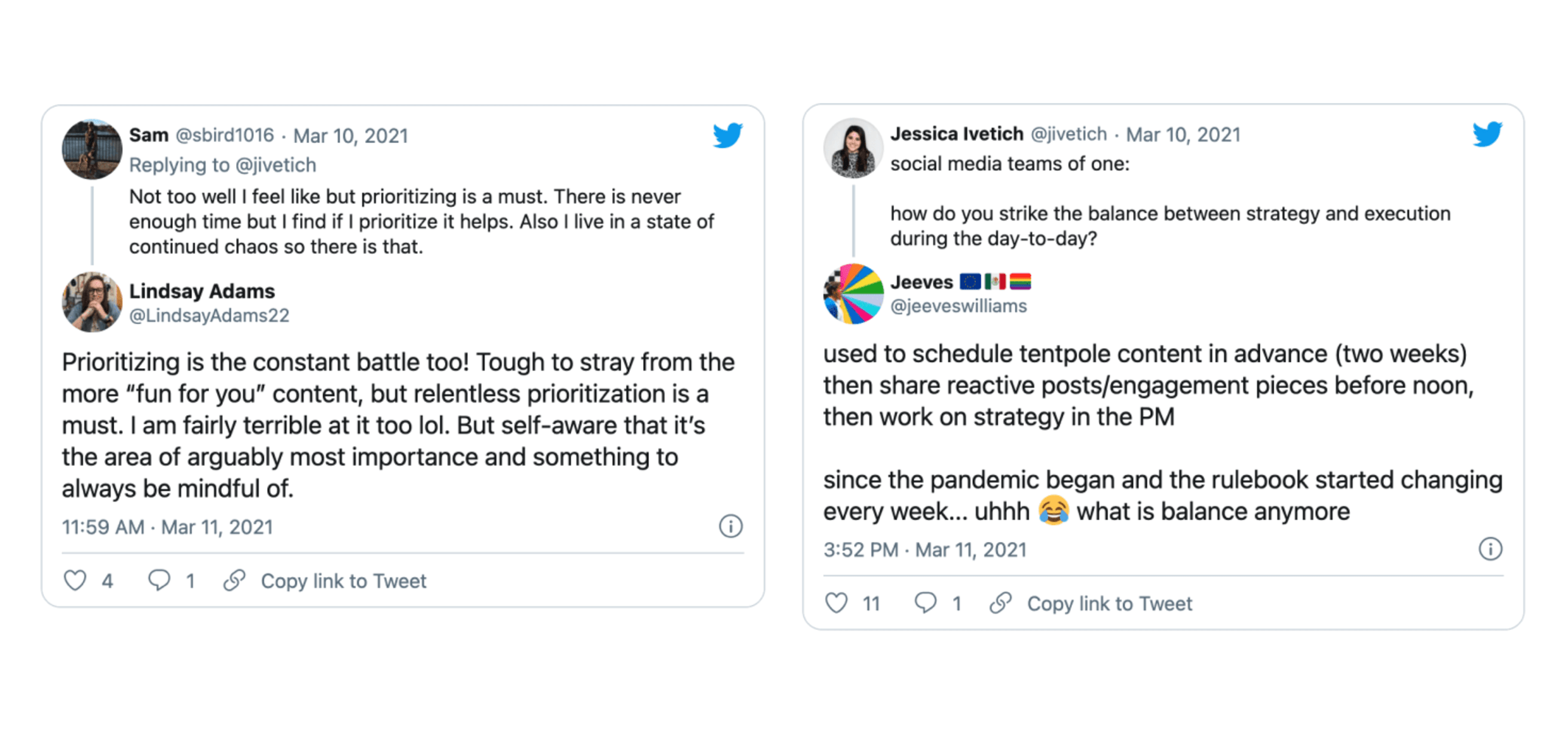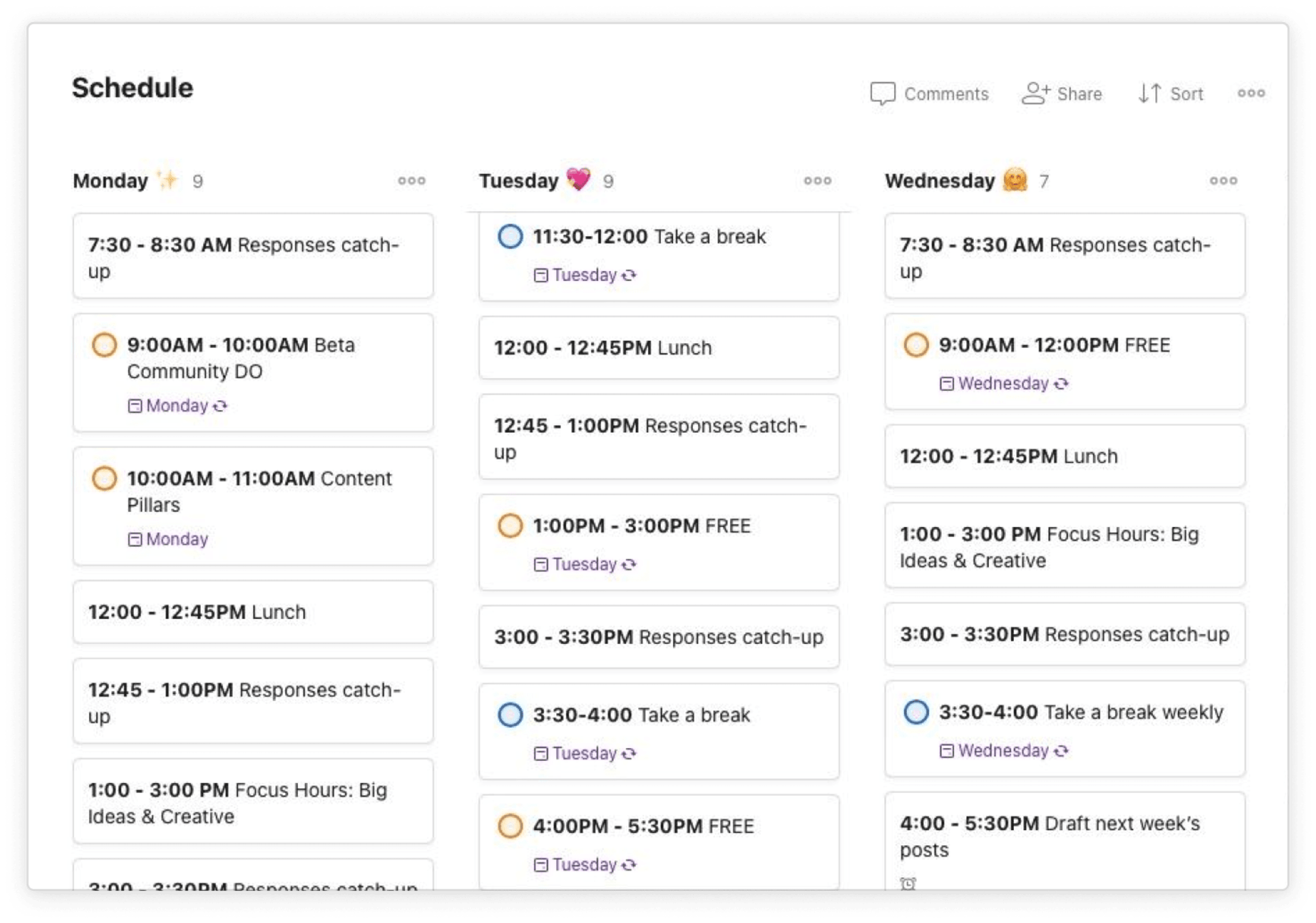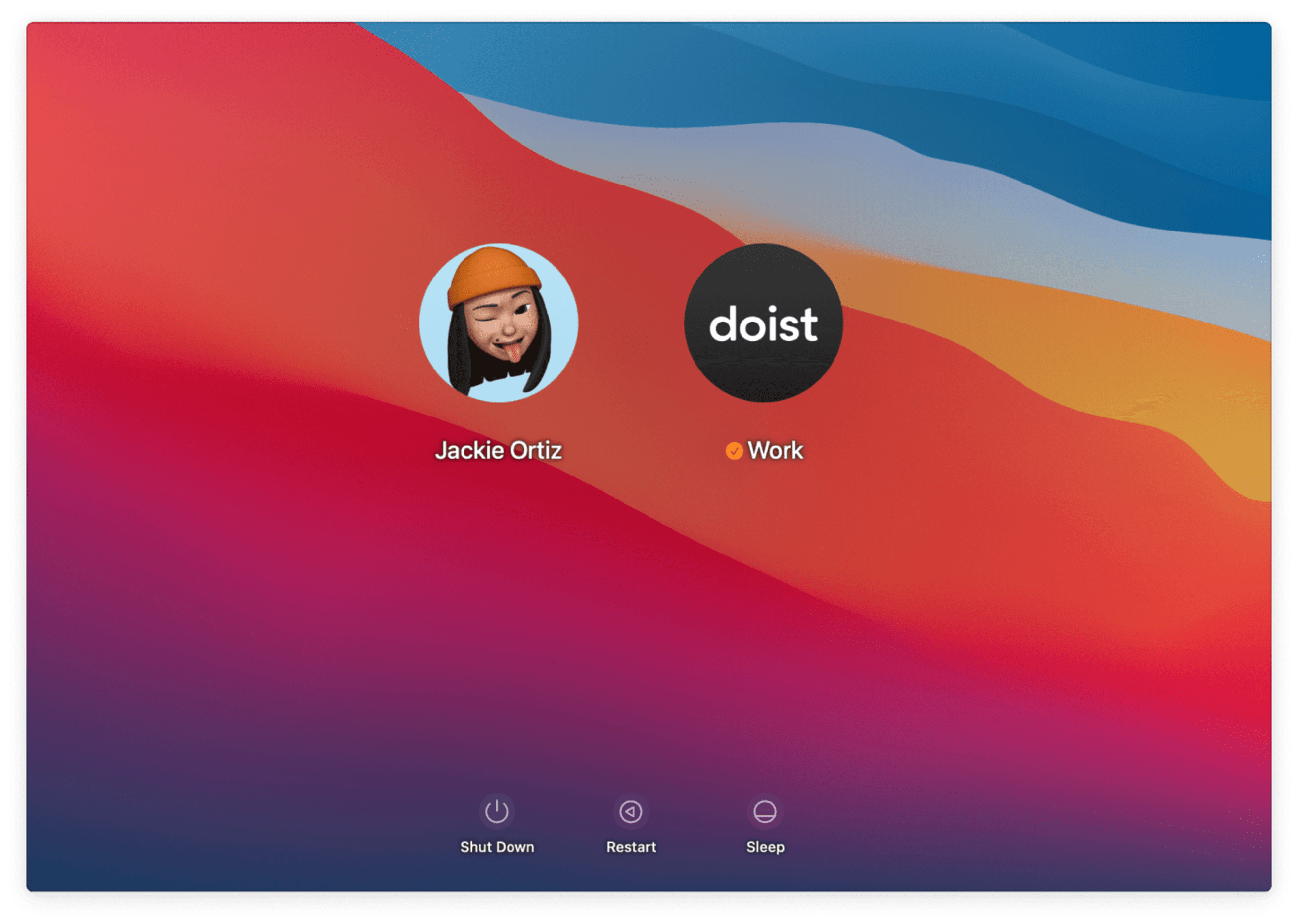The unavoidable truth is this: 2020 was very hard on everyone. From a global pandemic to political unrest, we’ve dealt with a never-ending barrage of online news. For many, the solution to escape the overwhelm and constant cloud of uncertainty came in the form of disconnecting. At Doist, we often encourage disconnecting. We write about it, make templates around it, and work to create a culture that allows our team to fully disconnect when needed.
Unfortunately, disconnecting proves to be difficult for social media managers, who are “always-on” in some capacity. In 2020, those in social media felt the weight of constant connection. Monitoring accounts throughout crisis, knowing when to pause posts, and steering through drastic global shifts only increased time online for social media managers.

The everyday challenges of the job, like managing trolls and navigating the daily news cycle, were heightened by an ever shifting landscape. COVID-19 expedited the remote work revolution (whether companies were ready or not), social injustices pushed social media managers and organizations to make ethical decisions on behalf of the brand, and doom scrolling became a daily practice. More time at home meant more screen time, and more screen time meant more social media.
As the year wore on, many social media managers took to Twitter, sparking conversations about how to better manage their mental health, prevent burnout, and continue to bring their best to their day-to-day work—all while balancing uncertainty. Despite marked improvements and the faint glimmer of light at the end of the tunnel in 2021, that cloud of uncertainty still looms overhead.

Regardless of the added challenges brought on by 2020, social media managers still need to do their work, and do it well. From increasing followers, writing copy, strategizing, embodying brand voice, staying atop social trends, and driving engagement—it’s no secret that a social media manager’s responsibilities run the gamut. How can social media managers (and anyone else who largely works online) do all of this while actively combatting the fatigue and burnout that accompanies the “always-on” nature of the job? Enter my rallying cry for deep work: the time (and sanity) saving tool that’s shifted my entire relationship with social media management.
Deep work as a healthy boundary
Cal Newport, an author and professor who coined the term “deep work,” defines it as:
“Professional activity performed in a state of distraction-free concentration that push your cognitive capabilities to their limit.”
Conversely, activities performed without focused intention fall into a category Newport defines as “shallow work”:
“Non-cognitively demanding, logistical-style tasks, often performed while distracted.”
My career in social has often felt like elbowing my way out of a crowded elevator every single day. That elevator is chock-full of shallow work: distractions, customer responses, emerging social platforms, and viral trends constantly vying for my attention.

Despite all this, there’s something inherently special about what we are able to do—building community, forming relationships with users, and being the virtual voice behind the brand. That love can sometimes come with blurry boundaries, though. In previous lives, I’ve worked during vacations, in the middle of loved ones’ birthdays, and even under my jacket at the movies.
Unsurprisingly, many social media managers have done the same:

Similarly, Newport has expressed concern about our “always-on” distraction culture:
“...the ability to perform deep work is becoming increasingly rare at exactly the same time it is becoming increasingly valuable in our economy. As a consequence, the few who cultivate this skill, and then make it the core of their working life, will thrive.”
Constantly waffling between real-time responses and the deep focus needed to create a long-term social media strategy is exhausting. Crafting a social strategy typically involves setting social goals (e.g. Increasing awareness, growing audience, generating conversions), researching and identifying the audience you want to develop, really getting to know your current audience, creating content pillars and themes, and more. Strategy lays the groundwork for social initiatives, both paid and organic. Most importantly, it gives each social post purpose and intention. Social strategy is the framework with which you're able to provide that special touch for a user on social because you’ve taken the time to get to know them and their relationship to your brand.
That’s why deep work quickly became my workday non-negotiable at Doist.
I view deep work as a boundary I clearly set in my work-life. It empowers me to focus on what really matters most. For a few hours at a time, I fully turn my attention to building social strategy, instead of getting lost in a sea of social responses.
There is no social strategy without deep work
Social media managers agree: it’s hard to do social well without social strategy. It’s challenging to build a cohesive social calendar with a mix of evergreen and timely posts without setting aside time for ideation and brainstorming. Yet, many social media managers are constantly clawing to find more time to be intentional about creating content that resonates with their existing audience and serves to attract new followers.


A deep work boundary in your everyday routine will give you newfound pockets of flexibility in your day that were previously occupied with reactively responding to customers or haphazardly planning tomorrow’s posts. Being intentional and building a foundation of deep work makes days feel less busy, and more productive.
An easy way to start setting your deep work boundary? Clearly identify what you constitute as “deep work” versus “shallow work.” Identifying the responsibilities will allow you to prioritize your day more effectively.
| Deep Work | Shallow Work |
|---|---|
| Writing copy | Monitoring social responses |
| Coordinating content | Replying to threads in Twist |
| Creating social strategy | Scheduling posts |
Once identified, make your deep work responsibilities absolutely non-negotiable. Use time blocking to reserve deep work time on your calendar, and the kicker: hold down the fort. Try not to, for any reason, move around your deep work time. Your deep work time is sacred.
Making space for deep work when you work in Social
Committing to deep work is one thing; carving out the time and space to actually work in focused concentration without distractions is something else entirely. Here are some helpful methods that have allowed me to set my deep work boundary (and actually stick to it):
Commit to 2-3 deep work sessions per week
Use time blocking to break up your day, or a productivity method like Pomodoro to do your real-time work in 25-minute sprints. I use Todoist to time block my week. Committing to focus hours every Monday, Wednesday, and Friday allows me to continue deep work on strategy and big picture ideas.

Separate personal vs work on your computer
Using the same computer to manage your work and personal life can smudge the boundaries you’re trying to set. If you’re in the same boat as me, using the same computer for work and life, keeping the brand accounts and work emails separate from your personal ones help lessen the noise. When the workday ends, or the weekend rolls around, log out of the “work” space and into your “personal” space.

Get real and radically candid with your team
Early in my career, with social being as an “emerging” field, it was easy to say yes to it all. Yes to posting on every single platform. Yes to running contests. Yes to spending every waking hour on social media. Too often, social media managers spread ourselves too thin. Spreading ourselves thin often means ignoring our needs. Ignoring our own needs leads to burnout. You can’t bring your best if you’re not feeling your best. Do a monthly (or weekly! Or daily!) check-in with yourself. Be honest about where you’re at and what you need from your team, even if that’s admitting social media’s toll on your mental health or needing to unplug to do your best work.
If you’re a team leader, encourage flexibility wherever possible and hold realistic expectations that you’re open to adjusting. Avoid (or minimize) long meetings and check-ins that can be done asynchronously. Allow for time away from social if it becomes daunting, and provide resources if needed to support your social media manager’s mental health.

Have an end of workday ritual, and stick to it
As more and more social media managers find themselves working remotely, an end of workday ritual becomes even more crucial.
I end my work days the same way I start them: writing in my gratitude journal. I reflect for 5-10 minutes on the day’s awesome moments, what I could have done better, and how I’m feeling.
Whether it’s cleaning off your workstation, or confronting all the tasks you’ve put off, an end of day ritual puts your mind at ease, and sets you up for tomorrow’s success.
Use a site blocker to work distraction-free
There are times when I’m working on social strategy or writing copy and my eyes glaze over and I somehow find my fingers click-clacking on my keyboard replying to a friends’ tweet. This happens to everyone, sure, but it’s especially easy when your entire job is to be on every platform.
Use a site blocker to tune out social distractions for 25 minutes, or even a few hours so you can focus on big picture ideas.
I use Freedom to lessen the noise and focus. I set up two distinct blocklists: a strict one for deep work, and another for social post planning. The app syncs across my Mac and my iPhone, so I’m not tempted to check social media across devices.

Unlike ever-changing social media platforms and those pesky security tokens you need to refresh every month, deep work is a practice that never gets old. It’s a tool that adds order to uncertainty, enabling more intentional planning.
Deep work is not a magic elixir that pulls social media managers away from the pressing need to be online, all the time. Moving away from an “always-on” culture is a paradigm shift that will require challenging the status quo and rallying together as a community to create a roadmap towards a healthier profession.
But deep work can coexist with your online responsibilities, help you do your best distraction-free work, and act as a catalyst for a more balanced life.

